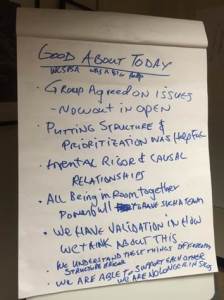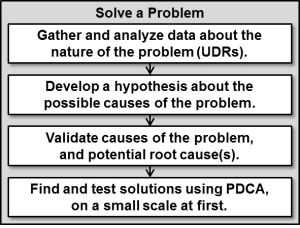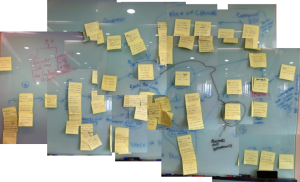We Have Met the Enemy of Sales Performance, and He Is Us
 Needless to say, trying to measure and improve sales and marketing performance can be frustrating.
Needless to say, trying to measure and improve sales and marketing performance can be frustrating.
You have to get people you may never even meet to pay attention, and ultimately to give you their money. Parts of it happen via media, such as a website, or in geographically disbursed customer locations. By definition, you do not know what prospects and customers will pay for. Their behavior cannot be controlled the way machines and materials can be controlled. There’s very little data telling you what to do.
Under these circumstances, how are your sellers and marketers supposed to determine the best methods of doing their work? Should scarce resources should be spent on marketing or tradeshows, websites or brochures, sales training or distribution channels, services, products, or something else? If a salesperson calls on a prospect for six months without winning an order, how does the company know if they have generated value or waste?
 For performance to improve, clear and simple answers to such questions must be found. Unfortunately, when things aren’t improving and time is running out, the forces of opinion tend to grow and multiply.
For performance to improve, clear and simple answers to such questions must be found. Unfortunately, when things aren’t improving and time is running out, the forces of opinion tend to grow and multiply.
This is where Pogo’s famous quote applies: Decisions need to be made. If those decisions are made without evidence and data to support them, “We have met the enemy. And, he is us.”
But how? There are so many possibilities. How can you determine what changes will result in improvement?
How can you know (with confidence) which few changes will give you the quickest and best results?
Operational Excellence to the Rescue
Operational Excellence relies on data-driven practices that begin with defining the problem you are trying to solve in precise terms, and then analyzing the evidence from a higher-level “systems” point of view.
In sales and marketing, where most of the work is invisible and not well understood, this may be no small task and may require an outside perspective. However you always start with basic problem solving, and it is possible to do it internally. Fortunately, if you are just starting out, small improvements typically produce big gains.
Here are the problem solving steps in a nutshell:
The best source of evidence and data is your own team. In sales and marketing the issue tends to be that they haven’t been asked or shown how to operationally define things. UDRs (undesirable results) are indispensable in this regard. (I’ve written pretty extensively about this, and a thorough discussion of problem solving and sales process design can be found in Sales Process Excellence.)
The most important thing is not to jump to the second step too quickly. UDRs are not to be trifled with (and neither is your sales process!). When it says “gather and analyze data” about the nature of the problem that is exactly what it means. Your team needs an environment that enables them to speak freely, and to discuss the issues from different points of view. It takes some time and effort for them to articulate a full picture of their situation. And, your situation is not just about problems. It is helpful to also find evidence and data about what is working as well.
Go Slow to Go Fast: This is a Marathon, Not a Sprint
Of course you want quick improvement. And you will find some quick easy things to fix. However, the last thing you want is to get everybody’s hopes up only to be back doing the same things you’re now doing after six months. The time you take in the beginning to help your team carefully gather and analyze your current context may feel uncomfortable, but it has a HUGE payoff.
Basically, “gathering and analyzing data” in this context means:
- Gathering UDRs (and perhaps some desirable ones as well) from everyone on the team to ensure their point of view is represented
- Articulate and validate these by verifying they are measurable, and whether data is available
- Organize the UDRs in to groups that seem to be related, or that have a similar cause (KJ Analysis is good for this)
- Arrange the groups of UDRs in a way that identifies likely causal relationships.
This work naturally moves the team toward finding data that helps locate where the problems are. The collage of images below are a typical early result (blurred slightly to protect client privacy):
It may look messy, but the minds of the participants are far more organized and motivated than they were before. Motivation is just about the most important thing if you want lasting improvement.
Step two is to develop a hypothesis about the possible causes of the problem, and you are probably not ready to go there just yet. It pays to dwell on the team’s perceptions, questions, and concerns first. You are dealing with sales and marketing here, and results won’t change until behavior changes. Behavior can’t change until people’s perceptions and their thinking change first. What are they really thinking? What do they have energy to change right now? What might they be reluctant to try at first? Why? What additional information would really help?
Leaders need to resist the temptation to rush into causes or call shots on the solutions. This is a marathon, not a sprint. The collective improvement momentum of a motivated, data-driven team trumps any short term gains the leader thinks he or she might be able to make. As the saying goes, the team needs to “form, storm, and norm before they can perform.”
Get On the Right Path
In addition to following the data trail, the team needs to start realizing their own personal versions of “We have met the enemy. And he is us.” Here are some things various teams have been surprised to learn in the early stages:
- More than 80% of our time is consumed after the sale on things that should not be happening
- We thought the bottleneck was with [department x], but in fact, we might be causing it ourselves
- We don’t have a method for learning what is working and not working in the field, and we need one
- We hate recording data, but if we don’t do something about it nothing is going to improve, ever
- Our lack of respectful agreement around how to do the work is perpetuating our problems
You’ll know you are on the right track if at the end of your working sessions you get feedback like this (also from a client workshop):
Good About Today:
WCSPSA (World Class Sales Process Self-Assessment) helped:
- Group agreed on issues (now out in the open)
- Putting structure and prioritization was helpful
- Mental rigor and causal relationships
- All being in the room together
- Powerful to have such a team
- We have validation in how we think about this
- We understand these things differently now (structure and rigor)
- We are able to support each other, we are no longer in silos
The team who gave that feedback is now ready to make real improvement. They are much less likely to “throw things on the wall to see if they stick,” and much more likely to find both the few small changes will give them the quickest and best result, AND the right strategic direction that will move them ahead of the competition, and increase the “Return on Sales Investment” line item in their company’s income statement.
Call to Action:
If you would like more information about helping your team create a well- integrated, measurable, improvable way to generate the profitable customer relationships you need, contact us.



